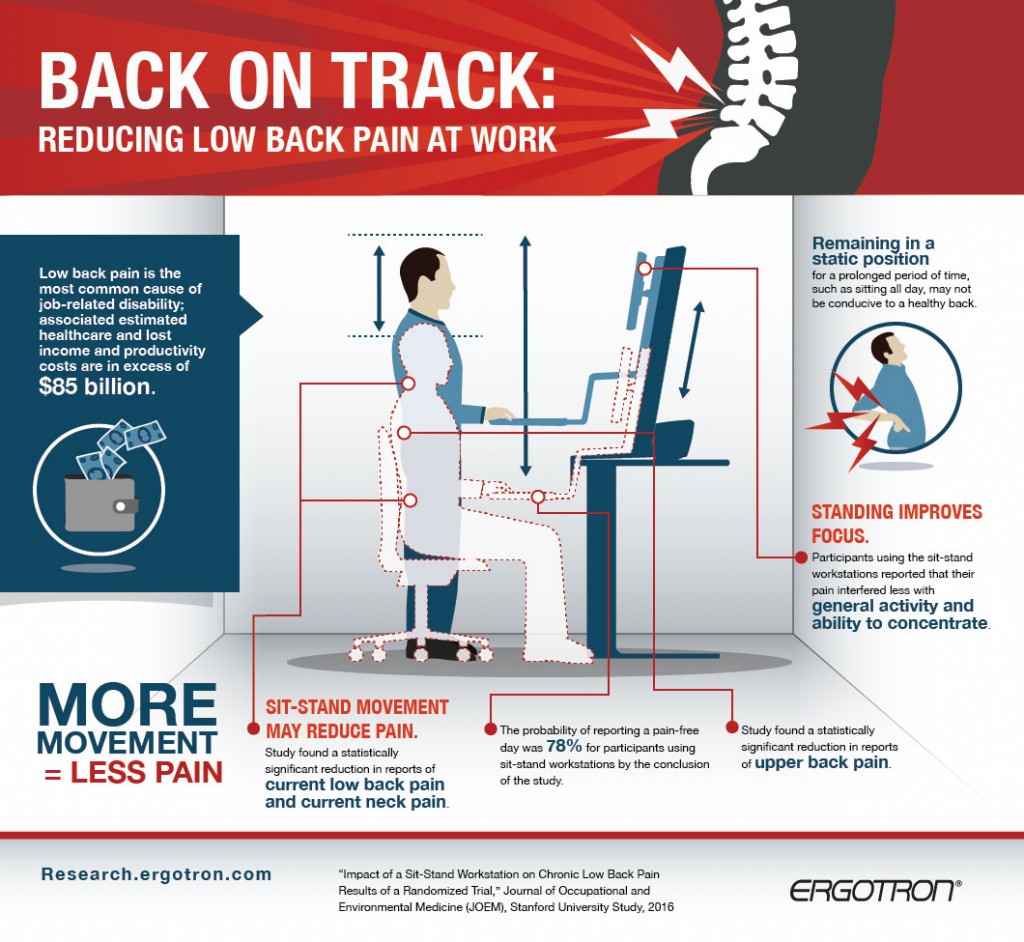
The study, “Impact of a Sit-Stand Workstation on Chronic Low Back Pain Results of a Randomized Trial,” published today in the Journal of Occupational and Environmental Medicine (JOEM) by Stanford University researchers Grant T. Ognibene, BA, Wilson Torres, BS, Rie von Eyben, MS, and Kathleen C. Horst, MD, concluded that low back pain may be improved by the introduction of sit-stand workstations which enable “postural variation” throughout the workday.
Here are the key findings:
- Reduced pain: At the end of the study, participants who used the sit-stand workstations were 78 percent more likely to report a pain-free day than those who worked at their regular workstations
- Quick intervention: Participants began to experience a difference in approximately 15 days after the sit-stand computer workstation was installed
- Increased concentration: Participants reported significantly lower back and neck pain, noting the pain was significantly less likely to interfere with their ability to concentrate
“These results reinforce the importance of movement and activity in creating a healthier workforce and population,” said Carrie Schmitz, senior research manager for Ergotron. “Businesses have a real opportunity to not only help their hurting employees start to feel more productive, but also proactively address the issues associated with prolonged sitting before they occur.”
The statistics around back pain are startling. Nearly 80% of all adults will experience lower back pain more than once in their lifetime1 and there are significant healthcare costs associated to this pain, with lost income and productivity estimated to be in excess of $85 billion.2 Also according to the study, currently, more than 75% of available jobs in industrial countries require employees to work in a sitting position,3 found to be linked with lower back pain.
The study, conducted onsite at Stanford, used a combination of 46 Ergotron WorkFit™ sit-stand workstations as intervention. The population being studied were formerly working at sit-only desks.
The researchers conclude that when given access to a sit-stand workstation, participants with chronic lower back pain reported significantly lower pain levels over time when compared with the control group. More study is needed to fully understand the impacts on pain and prevention of pain but until then, this study is a terrific starting point for workers and businesses alike to explore new alternatives to helping their employees feel better on the job and off.
- Dugan SA. The role of exercise in the prevention and management of acute low back pain. Clin Occup Environ Med. 2006;5:615–632. doi:101016/jcoem200603003.
- Martin BI, Deyo RA, Mirza SK, et al. Expenditures and health status among adults with back and neck problems. JAMA. 2008;299:656–664. doi:101001/jama2996656.
- Lis AM, Black KM, Korn H, Nordin M. Association between sitting and occupational LBP. Eur Spine J. 2007;16:283–298. doi:101007/s00586-006-0143-7.




Hello, can I have a pdf copy of this Stanford study/article?
I’ve heard that standing work stations help people lose weight and remain more mobile, but this seems like an interesting approach to managing back pain. Thanks for sharing!
Thanks for dropping by Rachel! As you know, back pain is a problem in quite a few workplaces. Sit-stand desks have been helpful for many people.